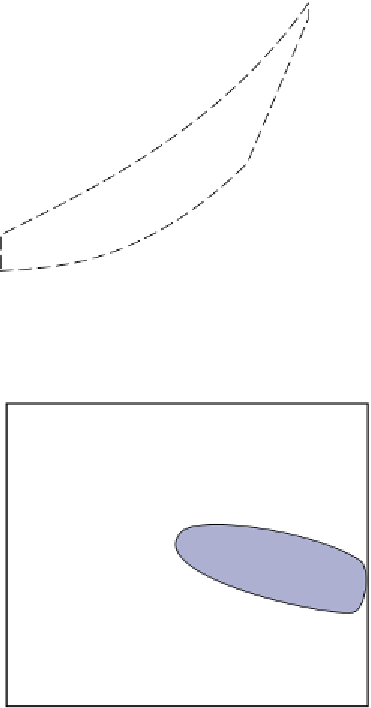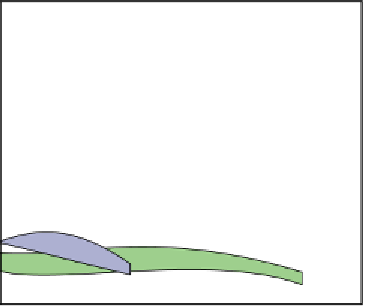Biomedical Engineering Reference
In-Depth Information
push-out
-TCP-reinforced PEEK
implants was 13% greater than that for PEEK alone
[24]
.
strength
of
b
(a)
25
human
cortical
bone (ll)
20
11.3.2 Functional Properties
A number of other functional properties are of
importance to bioactive PAEK composites. Dense
PAEK composites could conceivably be shaped
intraoperatively using a high-speed burr, whereas
porous PAEK composites could be shaped intra-
operatively using a scalpel or rongeur. The pore
architecture and interconnectivity of PAEK
composite scaffolds has been quantitatively charac-
terized using segmented micro-CT images
[28]
,but
there have been no experimental or computational
measurements of permeability to date. Calcium
phosphate reinforcement does not detract from the
advantageous radiolucency of PAEK, but may be
used instead of barium sulfate to tailor the radio-
pacity for visualization of an implant by X-ray
imaging. For example, PAEK reinforced with 40
e
50
vol%HA exhibits X-ray attenuation similar to human
cortical bone. Finally, just as the greater cost of
PAEK polymers over conventional biomedical ther-
moplastics (e.g., polyethylene) had to be justified by
enhanced performance, the added cost of raw mate-
rials and manufacturing bioactive PAEK composites
will have to be justified by additional performance
benefits in order to reach the market.
HA-PAEK
human
cortical
bone (
15
⊥
)
HA-oriented HDPE
HA-UHMWPE
10
5
HA-acrylics
HA-HDPE
HA-PLLA
0
0
10
20
30
40
50
60
Apatite Volume Fraction (%)
(b)
160
human
cortical
bone (ll)
HA-oriented HDPE
& HA-PLLA
140
HA-PAEK
120
human
cortical
bone (
100
⊥
)
80
60
HA-PMMA
40
HA-bis-GMA
20
HA-HDPE & UHMWPE
0
0
10
20
30
40
50
60
Apatite Volume Fraction (%)
11.3.3 Mechanical Properties
The mechanical properties of bioactive PAEK
composites have been evaluated by static uniaxial
tension
[12
e
14,20,21,25]
, cyclic uniaxial tension
[14,15]
, static uniaxial compression
[20,29
e
31]
,
implant push-out strength
[24]
, ultrasonic wave
propagation
[25,26]
, static four-point bending
[32]
,
cyclic four-point bending
[27]
, static three-point
bending
[33]
, and micromechanical models
[26,74,75]
. PAEK composites have exhibited
excellent static mechanical properties and fatigue
properties compared with other polymers with
bioactive reinforcements (
Fig. 11.6
). Both dense and
porous PAEK composites have been engineered to
mimic mechanical properties exhibited by human
cortical and trabecular bone tissue,
Figure 11.6
The elastic modulus (a) and ultimate
tensile strength (b) of human cortical bone tissue
compared to polymers reinforced with varying amounts
of HA. The mechanical properties of cortical bone are
shown for loading parallel
)
to the longitudinal anatomic axis. Note that the regions
are shown to simplify and be inclusive of a large
number of data points from the literature for high-
density polyethylene (HDPE)
[6,8,76]
, PAEK
[13e15,21,25]
, ultrahigh-molecular-weight polyeth-
ylene (UHMWPE)
[77]
, acrylicsdincluding polymethyl
methacrylate (PMMA)
[78e80]
and bisphenol-
a
-glycidyl
methacrylate/triethylene glycol dimethacrylate (bis-
GMA /TEG-DMA)
[81e84]
dPLLA
[85,86]
, and aniso-
tropic (oriented) HDPE
[87e90]
. The dataset was
limited to uniaxial tensile tests in order to be free from
ambiguity due to variations in testing methods (e.g.,
bending tests).
(
k
) and perpendicular (
t
respectively
(
Table 11.3
).
Dense HA-reinforced PEEK was able to mimic the
longitudinal elastic modulus of human cortical bone
at a similar volume fraction of HA
[12
e
14,25]




































































